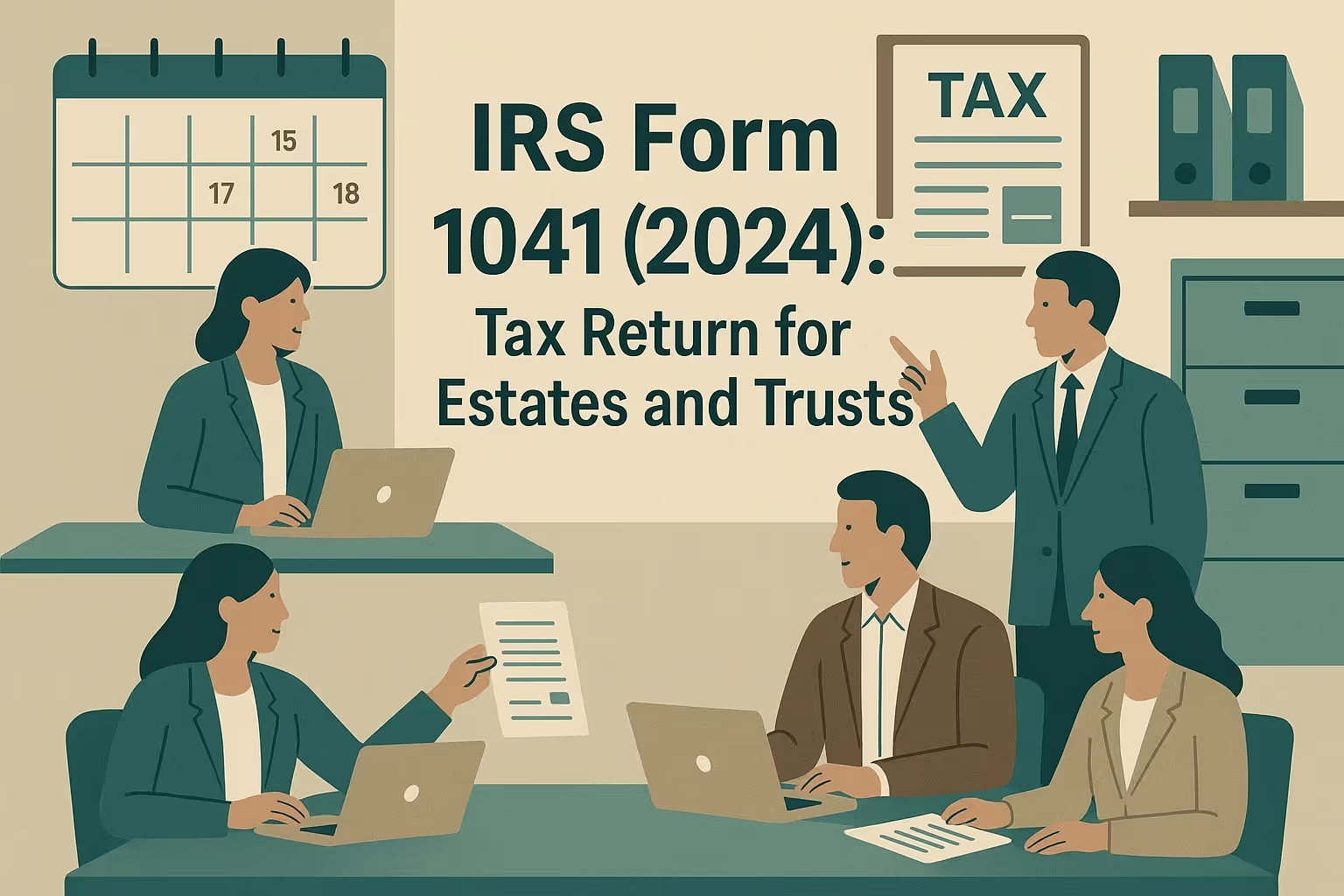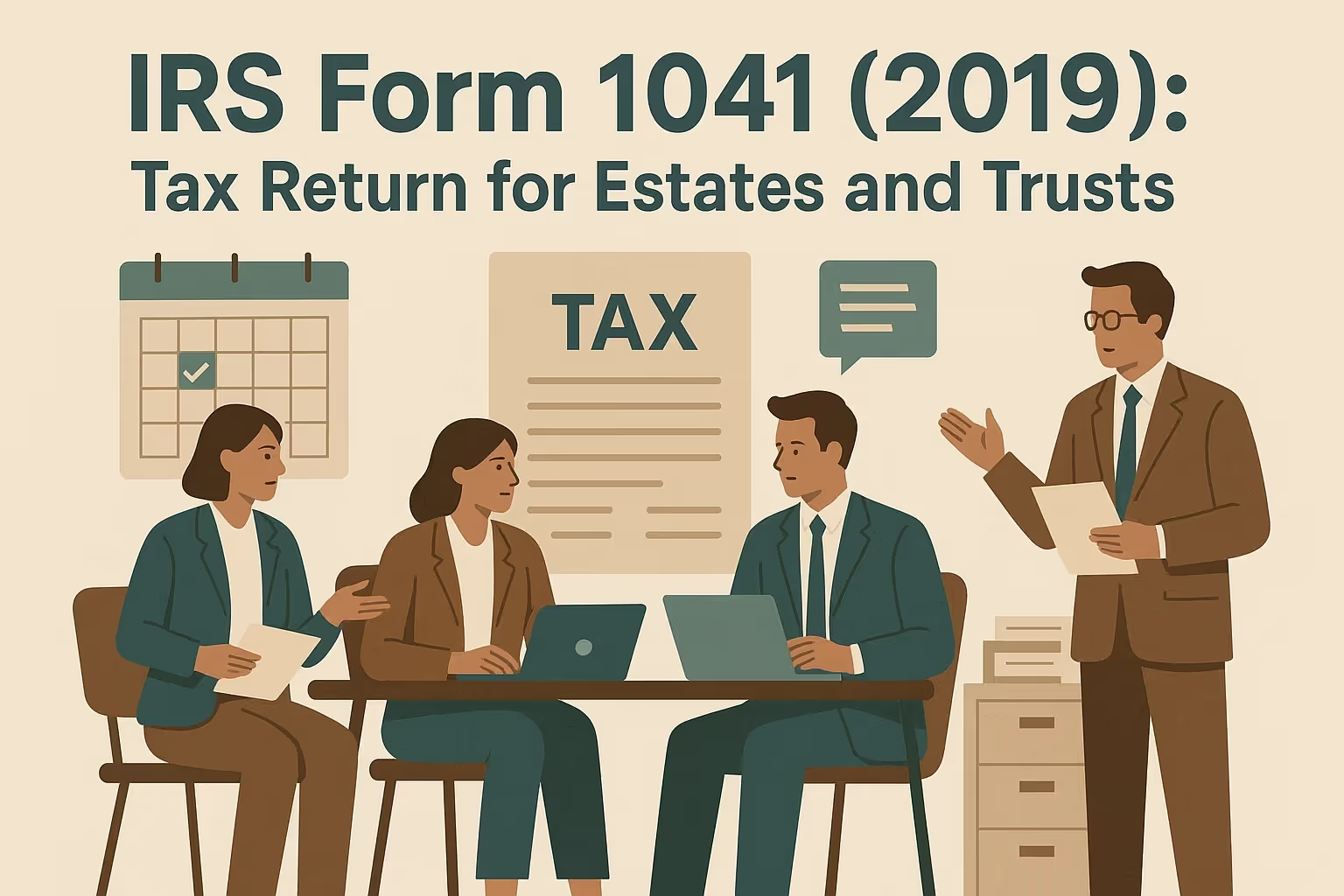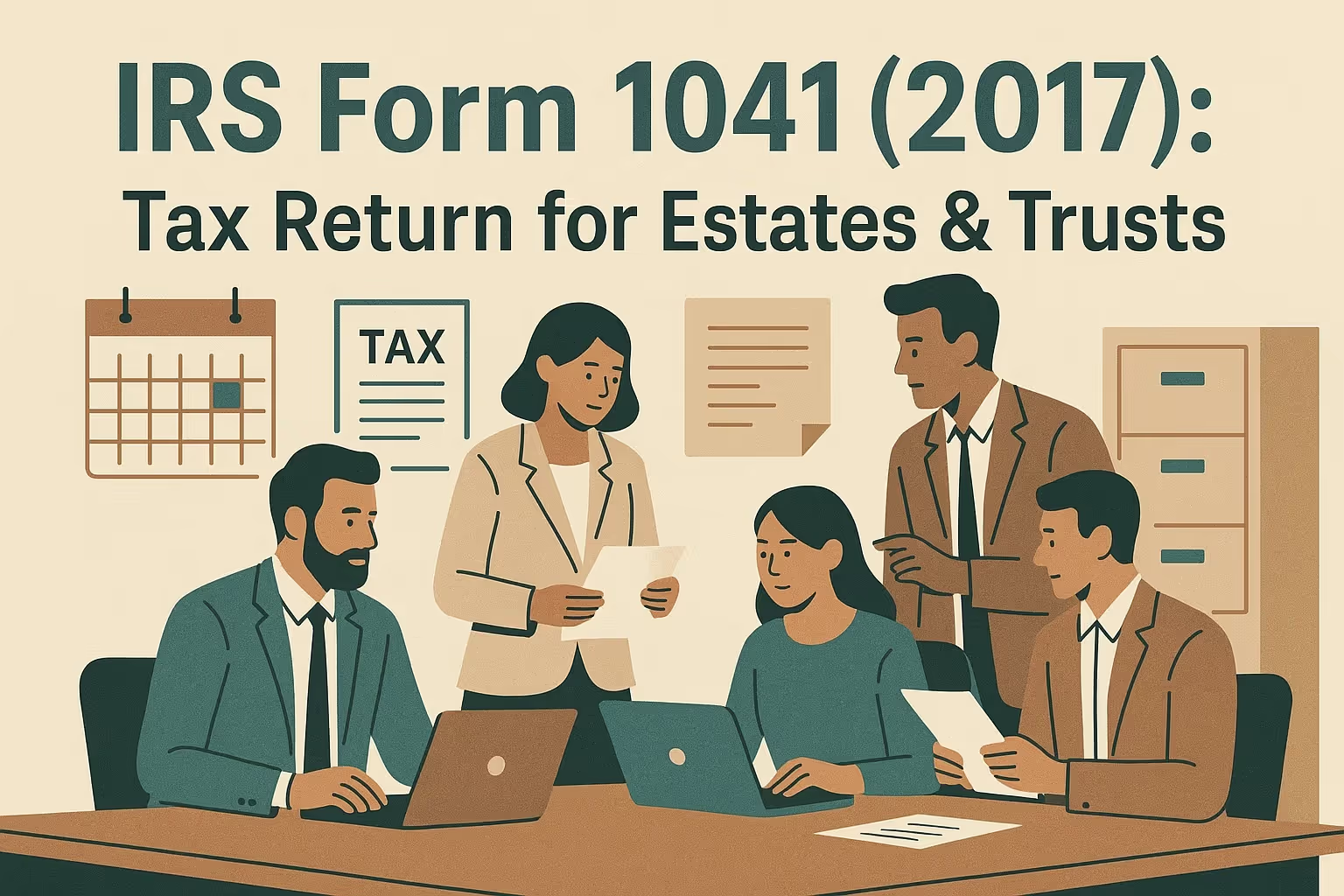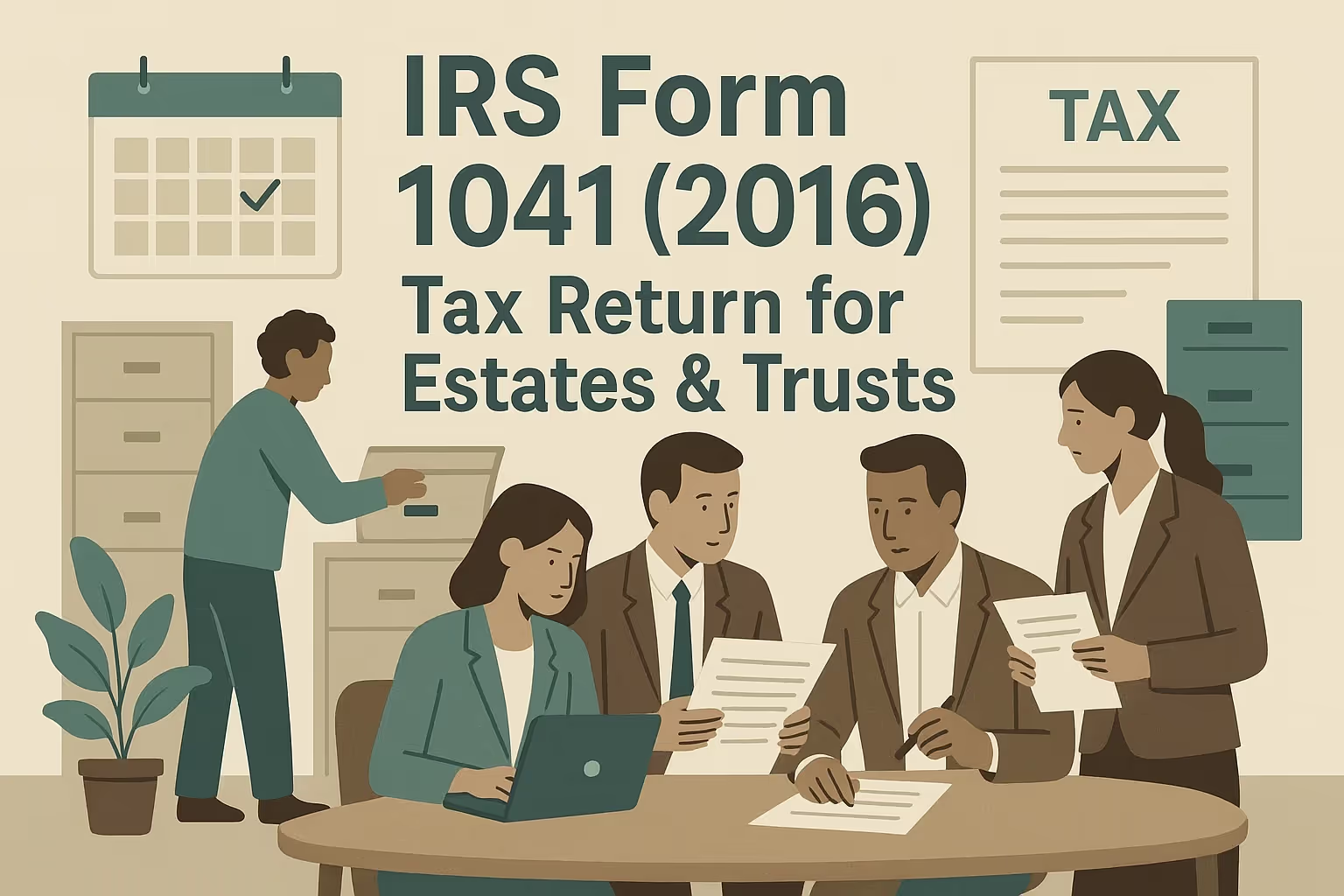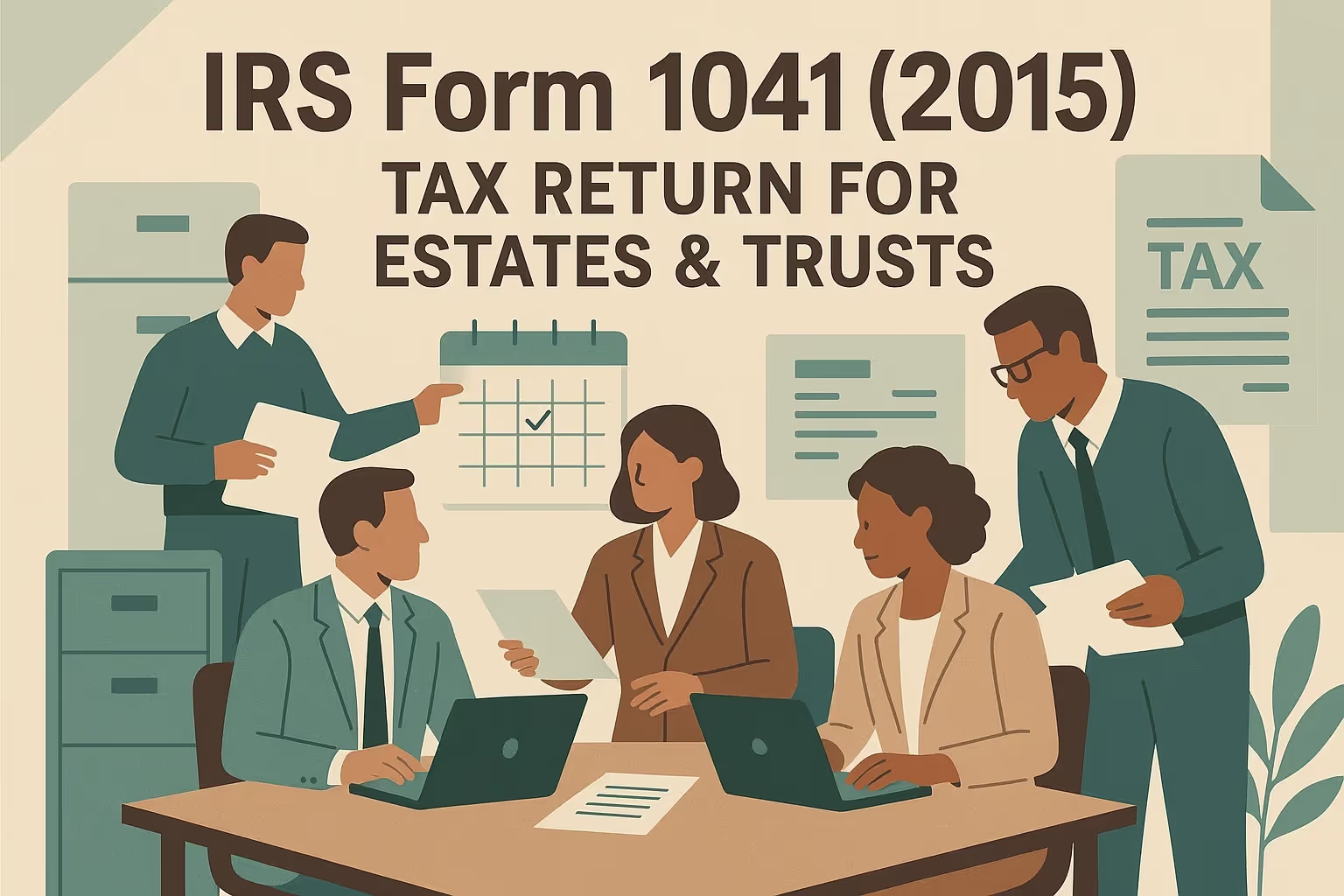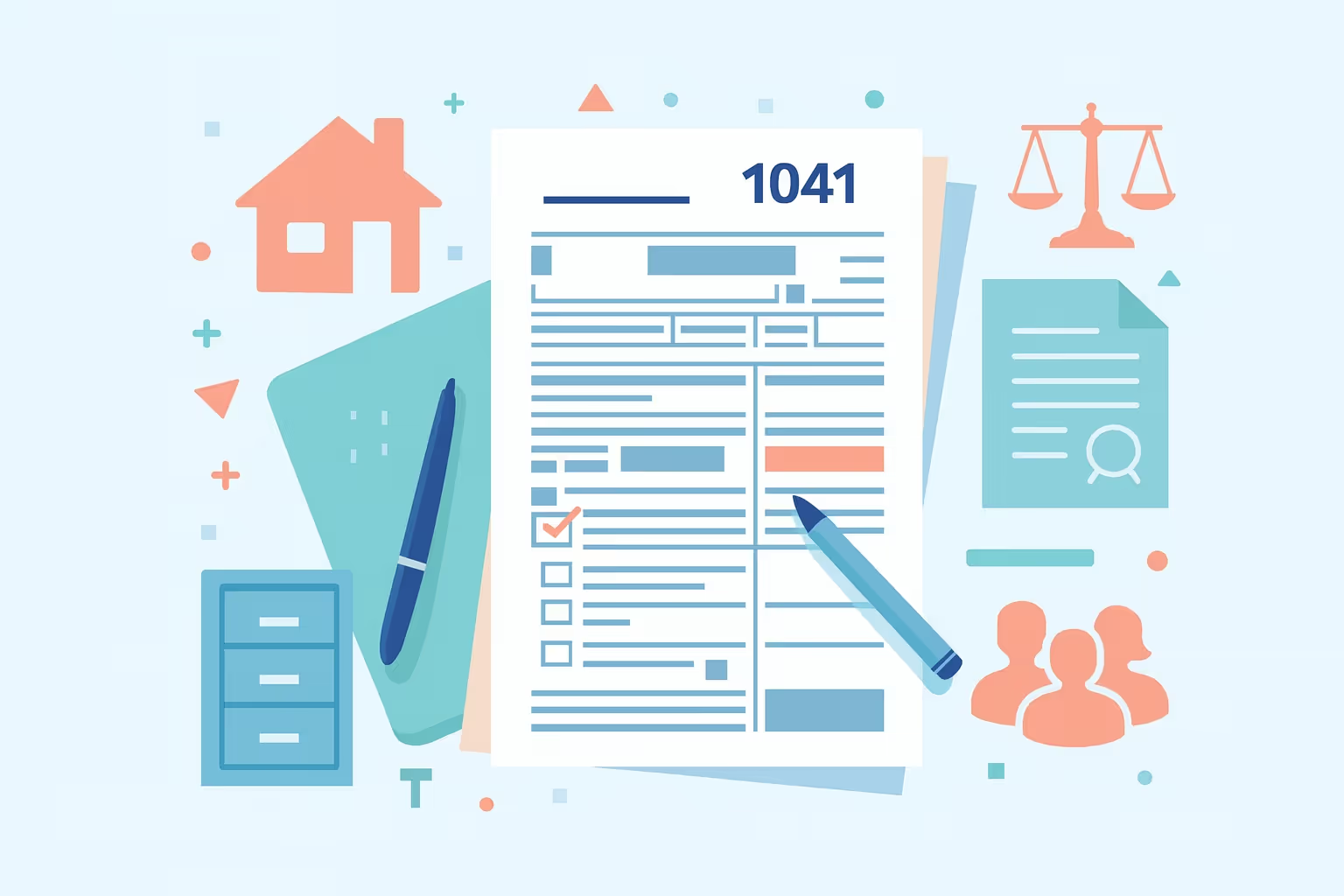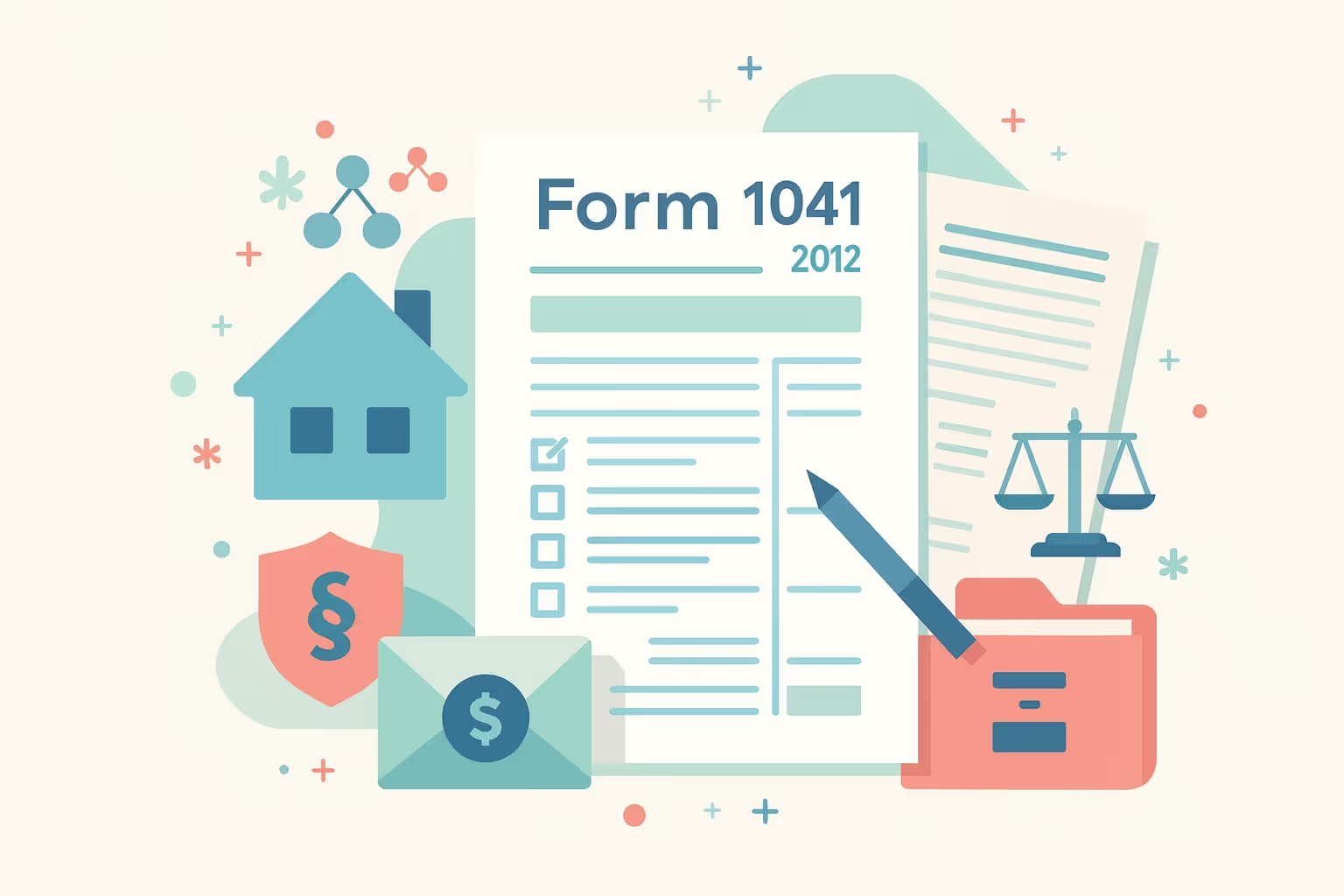IRS Form 1041 2016 Instructions for Estates & Trusts
Filing a federal income tax return for an estate or trust can be challenging, especially for first-time fiduciaries who are responsible for handling a decedent’s financial affairs. IRS Form 1041, officially titled U.S. Income Tax Return for Estates and Trusts, is used to report all the income, deductions, and distributions associated with an estate or trust. It serves a similar purpose as an individual’s personal income tax return, but applies to estates and trusts that continue to earn income after the owner’s death.
For the 2016 tax year, the Internal Revenue Service required fiduciaries to file Form 1041 to report income generated from assets such as interest, dividends, rental real estate, or capital gains. The form also helps determine how much of that income is taxed to the estate or trust versus how much is distributed to beneficiaries. Fiduciaries must understand their responsibilities under the Internal Revenue Code to ensure compliance and accurate reporting of all the income and deductions related to the estate or trust.
This guide provides clear, step-by-step instructions for Form 1041 2016 to help fiduciaries complete the process correctly. It explains how to calculate taxable income, apply the income distribution deduction, and understand essential filing deadlines. By following these instructions, fiduciaries can fulfill their duties, avoid penalties, and accurately report the tax obligations for both the trust and the estate.
Understanding IRS Form 1041
What Form 1041 Is and Why It Matters?
IRS Form 1041, also known as the U.S. Income Tax Return for Estates and Trusts, is used to report income, deductions, and other relevant tax information for estates and trusts. It helps the Internal Revenue Service determine the amount of income tax owed by the entity or its beneficiaries. Unlike a personal income tax return, which applies to individuals, this form is designed explicitly for estates and trusts that continue to generate income after an individual’s death.
Who Must File Form 1041?
The Internal Revenue Service requires a fiduciary to file Form 1041 for:
- A domestic estate that has gross income of $600 or more during the tax year, or if at least one beneficiary is a nonresident alien.
- A domestic trust that has any taxable income, gross income of $600 or more, or at least one nonresident alien beneficiary.
- Grantor trusts in which the grantor retains certain powers and is treated as the owner for income tax purposes.
- Foreign estates or foreign trusts that have income generated from U.S. sources or conduct business in the United States.
For income tax purposes, a fiduciary, such as an executor, trustee, or personal representative, is responsible for filing the return, paying any taxes imposed, and providing beneficiaries with their appropriate tax documentation.
Key Components of Form 1041
Form 1041 includes several significant parts that fiduciaries must complete accurately:
- Main Form (Pages 1–2): Reports all income earned, deductions, and the calculation of taxable income.
- Schedule A – Charitable Deduction: Used by complex trusts or estates that make charitable contributions.
- Schedule B – Income Distribution Deduction: Calculates the deduction for income distributed to beneficiaries.
- Schedule D – Capital Gains and Losses: Reports capital gains or losses from the sale or exchange of the trust’s assets.
- Schedule G – Tax Computation: Determines total income tax liability, including any credits or additional taxes.
- Schedule K-1 – Beneficiary’s Share of Income: Reports each beneficiary’s share of the same income, deductions, and credits from the estate or trust.
Each schedule serves a specific purpose and ensures the Internal Revenue Service receives accurate information about the entity’s financial activity. Completing these sections properly helps determine the correct allocation of tax between the estate or trust and the beneficiaries.
In summary, Form 1041 is essential for reporting the income earned by an estate or trust after an individual’s death. It ensures that all income, deductions, and distributions are accurately documented in accordance with the Internal Revenue Code, thereby maintaining compliance for both the fiduciary and the beneficiaries.
What’s New for the 2016 Tax Year?
Filing Deadline and Extension Updates
For the 2016 tax year, the due date to file Form 1041 was moved to April 18, 2017, to accommodate the Emancipation Day holiday in Washington, D.C. Fiduciaries could request an automatic extension of up to five and a half months by filing Form 7004. This extended the deadline to October 2, 2017, for estates and trusts operating on a calendar year. Fiscal year entities followed the rule of filing by the 15th day of the fourth month after the tax year ends.
Updated Tax Brackets and Exemptions
The Internal Revenue Service applied new income tax brackets for estates and trusts in 2016. These brackets were narrower than those for individual taxpayers, meaning estates and trusts were subject to higher rates with lower income amounts. Exemption amounts also changed, allowing a $600 exemption for estates, $300 for simple trusts, and $100 for complex trusts. Qualified disability trusts were eligible for a larger exemption amount of up to $4,050.
New Filing and Reporting Requirements
Several significant reporting changes applied for the 2016 tax year:
- Electronic filing requirements included Form 8453-FE and Form 8879-F for e-file authorization.
- Foreign asset reporting was expanded under Form 8938, requiring certain domestic trusts with foreign investments to disclose holdings.
- Form 8971 introduced consistent basis reporting rules to ensure beneficiaries receive accurate property valuations from the decedent’s estate.
- Net Investment Income Tax (Form 8960) applied a 3.8% tax to estates and trusts with income above $12,400.
These updates emphasized greater transparency and compliance, requiring fiduciaries to pay close attention to both domestic and foreign reporting rules.
Step-by-Step Instructions for Completing Form 1041
Step 1 – Gather Required Information.
Before completing the form, fiduciaries must collect the necessary documents, including:
- The trust agreement or governing instrument.
- The estate’s or trust’s taxpayer identification number.
- All records of income earned, such as interest, dividends, and capital gains.
- Documentation of deductible expenses, including fiduciary fees and administrative costs.
- Details of distributions made to beneficiaries.
Organizing these materials ensures accurate preparation and reduces the risk of errors or delays during the filing process.
Step 2 – Complete Entity Information (Top of Form).
The fiduciary should enter the legal name of the estate or trust, the name and title of the trustee or personal representative, and the entity’s address. The correct taxpayer identification number must be included. Additional boxes identify whether the return is initial, final, or amended. Estates that make the Section 645 election to be treated as part of a revocable trust must check the appropriate box.
Step 3 – Report Income (Lines 1–8).
All income generated during the year must be reported:
- Interest income: Includes interest from savings accounts, bonds, or notes.
- Dividends: Report ordinary and qualified dividends separately.
- Capital gains: Use Schedule D to document gains or losses from the sale of property.
- Rental real estate and royalties: Report income or losses using Schedule E.
- Business or partnership income: Include earnings from activities or investments related to the trust’s assets.
Accurate reporting of income earned ensures the proper calculation of taxable income and the correct application of tax imposed by the Internal Revenue Service.
Step 4 – Claim Deductions (Lines 10–16).
Deductions reduce taxable income and include the following categories:
- Interest paid on business or investment loans.
- Real estate and state income taxes related to the estate or trust.
- Fiduciary and professional fees, including attorneys and accountants.
- Administrative and operating expenses.
- Charitable deductions for qualified donations made by estates or complex trusts.
Fiduciaries must also consider expenses that are not subject to the two percent limitation under the Internal Revenue Code, such as fees directly related to the administration of the estate or trust.
Step 5 – Calculate Taxable Income (Lines 17–22).
After reporting income and deductions, fiduciaries calculate the taxable income by subtracting allowable deductions and exemptions from total revenue. Schedule B is used to compute the income distribution deduction, which determines how much income is taxed to the beneficiaries rather than the estate or trust.
Step 6 – Compute Tax and Payments (Lines 23–29).
The total income tax liability is computed using Schedule G. This includes regular income tax, the alternative minimum tax, and any applicable Net Investment Income Tax. Fiduciaries must also report estimated payments, withheld taxes, and any credits. If total payments exceed the tax owed, the fiduciary may request a refund; otherwise, payment must accompany the return.
Completing each section properly helps ensure accurate reporting and prevents penalties. A clear and organized approach enables fiduciaries to fulfill their legal obligations effectively.
Filing Options: Electronic vs. Paper
Benefits of E-Filing
Electronic filing is the most efficient way to submit Form 1041. It reduces processing time, minimizes errors through built-in software validation, and provides instant confirmation from the Internal Revenue Service. Fiduciaries can expect faster refunds and greater security compared to mailing paper returns.
E-Filing Procedures
To e-file Form 1041, fiduciaries must:
- Use IRS-approved software or an authorized tax professional.
- Complete Form 8453-FE or Form 8879-F for authorization.
- Submit the return electronically and retain copies of all signed documents for recordkeeping.
Form 8879-F can only be used for one return per year, while Form 8453-FE allows multiple submissions if required.
When Paper Filing Is Necessary
Paper filing may be required when specific schedules are unsupported by e-file systems or if the fiduciary prefers to submit a manual return. The return should be mailed to the appropriate IRS processing center, depending on whether payment is enclosed. When sending payment, Form 1041-V must accompany the check or money order.
Choosing the correct filing method ensures the return is processed efficiently and reduces the risk of delays or rejection by the IRS.
Payment Methods
Fiduciaries have several options for paying taxes owed on an estate or trust. The preferred method is through the Electronic Federal Tax Payment System (EFTPS), which allows secure online payments and immediate confirmation. Payments can also be made using a debit or credit card through an approved third-party processor, though convenience fees apply. If paying by check or money order, Form 1041-V must accompany the payment to ensure proper credit to the taxpayer identification number listed on the return.
Estimated Tax Payments
Estates and trusts that expect to owe $1,000 or more in income tax for the year must make estimated payments using Form 1041-ES. These payments are due quarterly in April, June, September, and the following January. To avoid underpayment penalties, fiduciaries should ensure payments equal at least 90 percent of the current year’s tax or 100 percent of the prior year’s tax liability. This requirement applies to both the trust and the estate when they continue earning income throughout the tax year.
Avoiding Penalties and Interest
Late filing and late payment penalties can add significant costs. The Internal Revenue Service generally charges a penalty of 5 percent per month for returns filed after the due date, up to a maximum of 25 percent of the tax owed. A separate 0.5 percent monthly penalty applies to unpaid taxes. Interest also accrues on any balance not paid by the due date. Filing Form 7004 to request an extension allows more time to file, but it does not extend the deadline for payment. Paying the estimated balance by the original due date helps fiduciaries avoid penalties and maintain compliance with the law.
Understanding payment options and deadlines enables fiduciaries to plan, fulfill filing obligations, and avoid incurring unnecessary interest or penalties on unpaid estate taxes.
Required Schedules and Attachments
Always Required
Most estates and trusts must attach specific schedules to ensure accurate reporting on Form 1041:
- Schedule B: Calculates the income distribution deduction and determines how much income is taxed to the beneficiaries.
- Schedule G: Computes the total income tax liability, including credits and any alternative minimum tax.
- Schedule K-1: Shows each beneficiary’s share of income, deductions, and credits and must be sent by the filing deadline.
Conditionally Required
Some schedules are only needed if specific activities occurred during the tax year:
- Schedule A: Reports charitable deductions made by a complex trust or an estate.
- Schedule D: Records capital gains or losses from the sale or exchange of property.
- Schedule I: Calculates alternative minimum tax for estates or trusts meeting AMT thresholds.
- Schedule J: Reports accumulation distributions for complex trusts with prior-year retained income.
Supporting Forms
Certain estates and trusts must include additional forms based on their financial activities:
- Form 4952: Reports investment interest expense deductions.
- Form 8960: Calculates Net Investment Income Tax when income exceeds $12,400.
- Form 8938: Discloses foreign financial assets held by the estate or trust.
- Form 8971: Provides consistent basis reporting for property transferred to beneficiaries.
All attachments should follow the correct assembly order: the main Form 1041, followed by related schedules and then supporting statements. Each attachment must include the taxpayer identification number of the estate or trust to ensure proper processing. Submitting complete schedules and forms helps the Internal Revenue Service verify taxable income and deductions efficiently.
Tips for First-Time Fiduciaries
Organization and Recordkeeping
A fiduciary must maintain complete and organized financial records. This includes copies of the trust instrument or governing document, prior year tax returns, bank and investment statements, and documentation of all distributions made to beneficiaries. Keeping accurate and timely records makes it easier to track income generated, deductions claimed, and payments made during the tax year.
Professional Assistance
Filing an income tax return for an estate or trust can be complex, especially when multiple beneficiaries or various types of assets are involved. Hiring a certified public accountant or enrolled agent who understands estate taxes and fiduciary rules can prevent costly errors. A professional can also assist with complex issues such as distributable net income, capital gains allocation, or foreign estate reporting requirements.
Communication with Beneficiaries
Good communication with beneficiaries is essential. Fiduciaries should provide beneficiaries with Schedule K-1 on time and explain how the income distributed affects their personal income tax return. Clear communication helps prevent misunderstandings and ensures beneficiaries receive accurate information about their share of the income and deductions.
Annual Planning
Effective planning allows fiduciaries to manage future obligations efficiently. Setting reminders for estimated tax payments, filing extensions, and record updates can prevent missed deadlines. Annual reviews of the trust’s assets and expenses also help ensure compliance with the Internal Revenue Service requirements and improve the accuracy of future filings.
Good organization, clear communication, and proper professional guidance make the filing process more efficient, helping fiduciaries meet their responsibilities with confidence.
Frequently Asked Questions
Who must file Form 1041 for the 2016 tax year?
A fiduciary must file Form 1041 if a domestic estate or trust has gross income of $600 or more during the tax year, or if any beneficiary is a nonresident alien. The Internal Revenue Service also requires a filing when an estate or trust has any taxable income or earns income generated from investments, property, or rental real estate, even if no distributions were made.
How does Form 1041 differ from a personal income tax return?
While a personal income tax return reports an individual’s earnings, Form 1041 reports income earned by an estate or trust after the owner’s death. It determines how the tax imposed is divided between the estate or trust and its beneficiaries. The fiduciary files the return under a taxpayer identification number rather than a Social Security number.
What is Distributable Net Income (DNI)?
Distributable Net Income represents all the income available for distribution to beneficiaries. It ensures that the same income is not taxed twice—once to the trust or estate and again to the beneficiaries. The DNI calculation determines the income distribution deduction and helps identify which portion of the trust income or estate income must be reported on each beneficiary’s share of the income.
How are charitable deductions and capital gains reported?
Charitable deductions are reported on Schedule A of Form 1041 for estates and complex trusts that make qualified donations. Capital gains are recorded on Schedule D and generally remain taxable to the estate or trust unless specified otherwise in the trust instrument or governing document. Accurate reporting ensures compliance with the Internal Revenue Code and prevents overpayment of income tax.
When should a fiduciary file an extension for Form 1041?
A fiduciary should file Form 7004 by the original due date if more time is needed to prepare the tax return. The extension provides an additional five and a half months to file, but does not extend the time to pay tax owed. Paying the estimated income tax liability by the due date prevents interest and late payment penalties.
How are income taxes calculated for estates and trusts?
Income tax for estates and trusts is calculated based on taxable income after allowable deductions, such as fiduciary fees, administrative expenses, and the income distribution deduction. Estates and trusts reach higher tax brackets more quickly than individuals, making accurate reporting essential. The Internal Revenue Service uses Schedule G to compute the total income tax liability and determine whether additional tax payments are required.






